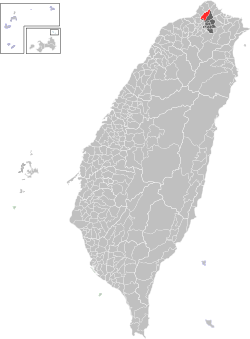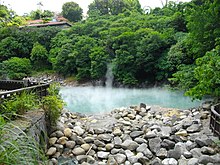| Beitou 北投區Hokutō | |
|---|---|
| District | |
| Beitou District | |
 View of Beitou from Mount Guanyin View of Beitou from Mount Guanyin | |
 | |
| Country | Republic of China (Taiwan) |
| Region | Northern Taipei |
| Divisions |
List
|
| Area | |
| • Total | 56.8216 km (21.9389 sq mi) |
| • Rank | Ranked 2nd of 12 |
| Population | |
| • Total | 241,250 |
| • Rank | Ranked 5th of 12 |
| • Density | 4,200/km (11,000/sq mi) |
| Postal code | 112 |
| Website | btdo |
| Beitou District | |||||||||||||
|---|---|---|---|---|---|---|---|---|---|---|---|---|---|
| Traditional Chinese | 北投區 | ||||||||||||
| |||||||||||||

Beitou District is the northernmost of the twelve districts of Taipei City, Taiwan. The historical spelling of the district is Peitou. The name originates from the Ketagalan word Kipatauw, meaning witch. Beitou is the most mountainous and highest of Taipei's districts, encompassing a meadow with rivers running through the valley which have abundant steam rising from them; the result of geothermal warming. The valley is often surrounded by mist shrouding the trees and grass. Beitou is famous for its hot springs. In March 2012, it was named one of the Top 10 Small Tourist Towns by the Tourism Bureau of Taiwan.
History
The area's hot springs had long been enjoyed by the aboriginal people of Taiwan. Shortly before the Japanese period a German sulfur merchant established the first hot spring club in Beitou.
During early Japanese rule, Hokutō (Pak-tâu) was a village at the entrance of the well-known North Formosa sulfur district. Three Japanese extracting plants in this district produced about 200 short tons (180,000 kg) of sulfur monthly. The Japanese had already recognized the value of the village as a sanitary resort and constructed a Japanese inn with hot mineral baths provided by the sulfur springs. The hot springs have been developed to include aroma therapy, massage, acupuncture, hydrotherapy, and excellent cuisine which complement the entire spa experience. The mineral waters stream from the numerous geothermal vents that occur naturally in the region and are famous for their health benefits.
Between 1920 and 1941, Hokutō Village (北投庄) was governed under Shichisei District, Taihoku Prefecture. It was upgraded to a Hokutō Town in 1941.
After the handover of Taiwan from Japan to the Republic of China in 1945, it was renamed as Peitou urban township (北投鎮), belonging to Taipei County. Beginning in 1949, Peitou and Shilin were administered by the newly formed Yangmingshan Administrative Bureau. Both of them were merged into Taipei City on 1 July 1968 as districts. In 1974, Yangmingshan Administrative Bureau underwent restructuring and Beitou District was placed under direct jurisdiction of Taipei City.
Economy
Asus has its headquarters in Beitou.
Institutions
Education

Universities and colleges:
- Dharma Drum Mountain Community University - Beitou Campus
- Fu Hsing Kang College
- National Defense University
- National Taipei University of Nursing and Health Science
- National Yang Ming Chiao Tung University
- Taipei City University of Science and Technology
- Taipei National University of the Arts
Junior and Senior High Schools:
- Taipei Municipal Zhong-zheng Senior High School
- Taipei Municipal Fuxing Senior High School
- Taipei Xin-Min Junior High School
- Taipei Beitou Junior High School
- Taipei Mingde Junior High School
Infrastructure
Tourism


Beitou has one of the largest concentrations of hot springs and spas in the world. Once a small park where locals used to relax in the hot springs, the Beitou Valley has evolved today to include over thirty resorts; a 20-minute subway ride north of Taipei takes you to Beitou. The resorts and spas are regarded by many locals and international tourists as among the most relaxing and rejuvenating places in the country. The spas consist of different degree pools (from cool to very hot) and minerals. However, residents of this district note that sulfuric fumes from the hot springs do ruin their electric appliances in the long term.
Tourist attractions
- Beitou Hot Spring Museum
- Beitou Museum
- Beitou Park
- Beitou Plum Garden
- Beitou Presbyterian Church
- Grass Mountain Chateau
- Guandu Nature Park
- Guandu Temple
- Hong-Gah Museum
- Ketagalan Culture Center
- Kuandu Museum of Fine Arts
- Lady Zhou's Memorial Gate
- Nung Chan Monastery
- Taipei Public Library Beitou Branch
- Thermal Valley
- Tittot Glass Art Museum
- Yangmingshan National Park
- Zhongxing Guesthouse
- Zhuzihu Ponlai Rice Foundation Seed Field Story House
- Hot Springs in Xin Beitou and Xingyi Road
- Beitou Cape: Lighthouse and seaside resort
- Puji Temple
- Zhongzheng Mountain
Transportation

The district is served by Beitou Station, Xinbeitou Station, Zhongyi Station, Qiyan Station, Fuxinggang Station, Guandu Station, Qilian Station, Mingde Station and Shipai Station of the Taipei Metro.
Notable people
- Ashin – singer, songwriter and author
- Gingle Wang – actress and writer
- Tai Chih-yuan – comedian, actor and show host
See also
References
- Jacobs, Andrew (2010-03-21). "Taiwan's Steaming Pools of Paradise". The New York Times. Retrieved 2010-07-12.
- Wong, Maggie Hiufu (2012-03-30). "Taiwan names its 10 top small tourist towns". CNN Go. Archived from the original on 2012-04-02. Retrieved 2012-03-31.
- "Getting in Hot Water: Welcome to Taiwan's Geothermal Springs". topics.amcham.com.tw. American Chamber of Commerce in Taiwan. 7 December 2020. Retrieved 21 December 2020.
- Davidson, James W. (1903). The Island of Formosa, Past and Present : history, people, resources, and commercial prospects : tea, camphor, sugar, gold, coal, sulphur, economical plants, and other productions. London and New York: Macmillan. p. 621. OCLC 1887893. OL 6931635M.
- "Archived copy" (PDF). Archived from the original (PDF) on 2018-05-23. Retrieved 2014-09-14.
{{cite web}}: CS1 maint: archived copy as title (link) - "2007 Corporate Sustainability Report Archived May 21, 2009, at the Wayback Machine." Asus. 10 of 67. Retrieved on March 15, 2010. "ASUS has its headquarters located in No. 15, Li-Te Rd., Beitou, Taipei 11259, Taiwan."
External links
 Beitou travel guide from Wikivoyage
Beitou travel guide from Wikivoyage- Official website
 (in Chinese)
(in Chinese) - - Photos of Beitou by Junewei(Wayne)
- Ku, Melody. Travel Taiwan. Central Coast Magazine, San Luis Obispo, CA. Dec. 2004.
- https://web.archive.org/web/20120226062458/http://www.go2taiwan.net/monthly_selection.php?sqno=23
| Districts in Taiwan | |||||||||||||
|---|---|---|---|---|---|---|---|---|---|---|---|---|---|
| List of townships/cities and districts in Taiwan | |||||||||||||
| Special municipalities |
| ||||||||||||
| Cities |
| ||||||||||||
| ¹ — Mountain indigenous district | |||||||||||||
25°07′00″N 121°30′00″E / 25.1167°N 121.5°E / 25.1167; 121.5
Categories: